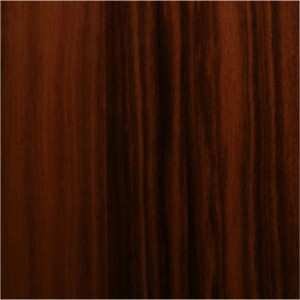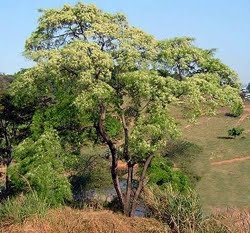Dark and distinctive, Curupay, or Cebil, is a great choice for a great many applications.
Common trade names: Cebil, Curupay
Genus: Anadenanthera colubrina (syn. Anadenanthera macrocarpa)
Janka Hardness (pounds-force): 3630
Description: Curupay features deep brown to brown-red hues, characterized by prominent streaking, regularly following the grain patterns of the wood. The grain is highly interlocked and moderately figured, and Curupay has a fine to moderate texture.
Location: Latin America, specifically: Argentina, Brazil, Paraguay, Peru, Bolivia
Common Aliases: Angico, Cambui-ferro, Cebil moro, Curupay-ata, Guarapiraca
Performance: Almost as hard as any wood available, this is a fine choice for exterior application. It is highly insect and rot resistant, and is a more or less generational solution for the designer or homeowner. It’s very distinctive, and if architects or designers are searching for a wood that will “pop,” this is one species that can do the job, and can stand the test of time.
Acclimation: Please, always properly store and set aside your lumber! We can’t stress enough the importance of just a little patience when receiving your order. For air drying, simply allow a half-inch or so among parallel planks stacked and spaced by level. It’s that easy, and in two or so weeks’ time, the lumber is ready for installation in your climate!
A Curupay tree, found commonly in South America.
Common Uses: Tool handles, docks, chemical containers, foundation pilings, furniture, ground contact, vehicle parts, wharf building, exterior and interior trim, rain screen siding, shiplap, turnings.
From: The Wood Database
Common Name(s): Cebil, Curupay
Scientific Name: Anadenanthera colubrina (syn. Anadenanthera macrocarpa)
Distribution: Argentina, Brazil, and Paraguay
Tree Size: 65-80 ft (20-25 m) tall, 2-3 ft (.6-1.0 m) trunk diameter
Average Dried Weight: 66 lbs/ft3 (1,060 kg/m3)
Basic Specific Gravity: .86
Hardness: 3,630 lbf (16,150 N)
Rupture Strength: 28,010 lbf/in2 (193,180 kPa)
Elastic Strength: 2,639,000 lbf/in2 (18,200 MPa)
Crushing Strength: 14,100 lbf/in2 (97.2 MPa)
Shrinkage: Radial: 4.6%, Tangential: 7.6%, Volumetric: 12.0%, T/R Ratio: 1.7

